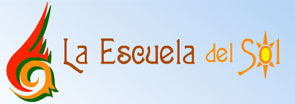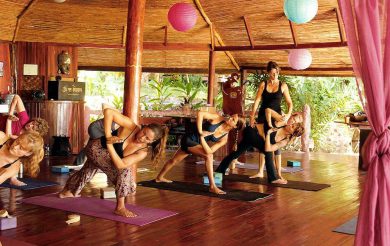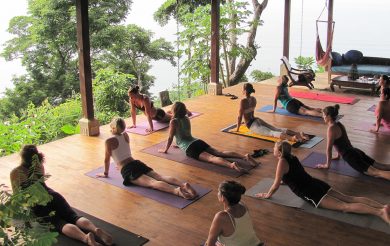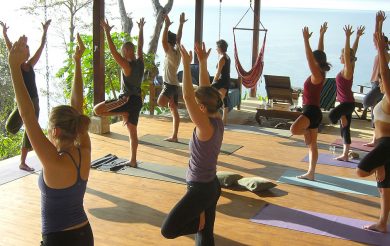- Home
- Accommodation
- Activities
- Area Info
- Maps
- Photo Galleries
- Real Estate
- Travel
Curu National Wildlife Refuge
Curú National Wildlife Refuge, known in Costa Rica as “Refugio Nacional de Vida Silvestre Curú” is the best park in the southern Nicoya peninsula. It offers scuba diving, a beautiful white sand beach, tons of wild animals including two reintroduction programs, cabinas for rent, mangrove swamps, hiking trails, and much more. You can even meet a friendly spider monkey who will hold your hand!
Scary but fun – rickety bridgeUnfortunately, most tourists zip right past it on the way from the Puntarens/Paquera ferry to Montezuma, Santa Teresa, or Tambor, never knowing what they’ve missed.
The park has a rich history. It was originally purchased in 1933 (for 12,000 colones!) by the Schutt family, who began converting it into a multi-use sustainable development that included selective harvesting of lumber, agriculture such as rice, beans, plantains, and corn, an teak plantations. Cattle farming was included as well, and is still part of the farm.
Currently it has three parts, out of 1496 hectares:
84 Ha: The beachfront “Curú National Wildlife Refuge”
1100 Ha: Protected Forest/Jungle
312 Ha: Sustainable Farm with Cattle and Agriculture
Curú Hacienda and National Wildlife Refuge is located on the southeast part of the Nicoya Peninsula in Costa Rica, Central America. It was instituted in 1933 by Federico Schutt de la Croix and is family owned till date. The area was acquired from Pacific Lumber Company, a foreign entity that developed the area for indigenous tropical trees such as mahogany, rosewood, and cedar. This region was converted into a manifold use, sustainable development initiative that included the choicest timber harvest and agricultural plantations including rice, beans, corn, plantains, and in the later stages even mangos and teak trees.
Doña Julieta Schutt de Valle arrived in the area as a schoolteacher in the early 1950’s and met Frederico whom she went on to marry later. Their children were actively involved in implementing several programs related to monkey and ocean/coastal creatures’ conservation, as well as eco sustainable activities such as nurturing small plantations.
In 1974, a squatters settlement took over part of the region that led to the formation of the present day Valle Azul, where several of the squatter families still reside. Curú subsequently began concentrating on protecting the region’s significant habitats for several endangered species. In 1981, it received an official status from the Costa Rican government to protect its threatened forests and mangroves. In 1983, Curú National Wildlife Refuge officially came into being created. In the last 20 years, the Schutt Valle family, who manages Curú Hacienda and National Wildlife Refuge, has transformed the area into an ecotourism destination and study center for students and scientists from around the globe. Though a wildlife refuge now, it still acts as a working ranch.
The Curú Hacienda and National Wildlife Refuge is a living example of how sustainable development can work to produce a profit and jobs for local Costa Ricans, as well as protect important habitats for many wildlife and marine species. When Frederico Schutt de la Croix past away, the area became an association name Adelina, S.A. The transformation of the area into the present day Curú Hacienda and National Wildlife Refuge has been possible due to the dedication of Doña Julieta Schutt de Valle, who still manages the ecotourism projects and is a dedicated supporter of conservation, research, and student groups using the area for educational purposes.
The area features abundant wildlife and some of the most scenic beaches and bays on the Nicoya region. Here, wildlife enthusiasts can spot some of the area’s most sought after species such as the white-faced monkeys, howler monkeys, spider monkeys, scarlet macaws, white-tailed deer, collared peccary, coati, raccoons, coyotes, iguanas, and innumerable species of indigenous and migratory birds.
The Curu National Wildlife Refuge contains a total of 1,496 hectares including deciduous and semi-deciduous forests, mangroves, beaches, ocean habitats, lush green pastures, and rich plantations. About 1,100 hectares are protected forest (75%), 312 hectares are reserved for grazing pastures and agriculture (20%), and approximately 84 hectares is the actual Curú National Wildlife Refuge (5%). The forests are preserved as part of a private wildlife refuge that is nestled along the Peninsular Biological walkway. There are several trails within the refuge and preserved forest area, including effortless hiking paths and the more challenging, long-winded trails.
Species Spotted in the Park
Visitors and wildlife researchers/enthusiasts can explore diverse wildlife groups from reptiles, amphibian, mammals and birds in the park. The area is known for its varied habitats owing to the preservation of habitats of several types. Here more than 230 species of birds, 75 species of mammals, 85 species of reptiles, and over 500 species of flora has been identified till now. Curú houses a spectacular combination of indigenous dry and moist forests, and sea habitats. For visitors who come to the refuge for day trips, the best times for bird watching are 7-9 AM and 3-4 PM.
Some of the most commonly sighted birds here include the orange-fronted parakeet, yellow-naped parrot, scarlet macaw, long-tail manakin, lineated, pale-billed, and Hoffman’s woodpeckers, osprey, common black hawk, barred antshrike, blue-crowned and turquoise-browed motmots, black headed, violaceous, and elegant trogons, brown pelican, crested caracara, flycatchers, tanagers, vultures, herons, and several species of migratory song and coast birds. Regularly spotted mammals here include white face, spider, and howler monkey, raccoon, coati, squirrels, anteater, white-tail deer, armadillo, tayra, collared peccary, margay, puma or mountain lion, skunk, and kinkajou. Other than that the oftn seen reptiles and amphibians include giant toad, boa constrictor, iguana, sea turtles, Anolis lizards, and crocodile.
Conservation Initiatives
The Curu National Wildlife Reserve serves as a living laboratory for the student community, scientists, and researchers. The park hosts several school programs and educational seminars, while also facilitating conservation projects protecting migratory such as the endangered scarlet macaw. Other initiatives include restoration of artificial and coral reefs, parrot conservation, and reintroduction of spider monkeys into the wild.
Scarlet Macaw Restoration Program- In 1999, a Costa Rican conservation organization called Amigos de las Aves kick started a Scarlet Macaw (Ara macao) restoration program in Curú. 13 Scarlet Macaws were let out and were left for independent foraging. The survival rate has been more than 90% every year. Their nestling is being continuously documented. In July 2004 two young birds of around 4-5 months of age were recorded flying with the flock. This was the first successful breeding of reintroduced Scarlet Macaws in Costa Rica. The macaws can be spotted within the refuge’s premises and are often seen foraging on almonds along Curú’s beautifully untouched coast and in the more open areas of park.
This program is conducted with the assistance of native biologists and volunteers. There are currently volunteer openings for this project. For more information on the project or if there is a genuine interest in working as a volunteer or creating an independent research initiative in Curú, the founders of this program can be contacted. Funding for this research project has been provided by the Lincoln Park Zoo Neotropic Fund, Columbus Zoo Field Conservation Funds, Cleveland Metroparks Zoo Scott Neotropical Fund, Loro Parque Foundation, Kaytee Avian Foundation, Bird Clubs of Virginia, Amigos de las Aves USA, Pacific Importers, and private donations.
Spider Monkey Reintroduction Program – The Set Us Free Project included the reintroduction of the fast depleting Spider Monkey population in an isolated region of the wildlife refuge. The Spider Monkey was almost on the verge of extinction on the Nicoya Peninsula and this initiative focused on developing a solid plan for creation and implementation of successful programs emphasizing the reintroduction of Spider Monkeys in the wildlife habitats. Thanks to the efforts of the park, many spider monkeys are foraging independently and several pairs have successfully bred in the refuge in the last few years. More initiatives are in the offing now and a comprehensive research program is being developed for the species now. A significant element of this project is to get the monkeys accustomed to a pre-release cage far from human contact. A feeding program has been carried out in the initial stages of the monkeys’ release, until they are capable to forage on their own.
Environment Education Programs
Environmental education programs connected to the Scarlet Macaw, Spider Monkey, and marine species projects have been created and implemented with much success in the Curú National Wildlife Refuge. For instance, several batches of local school children visited Curú in 2004 and were taken to a pot in Curú Bay that hosts a coral reef. The school children were told about the importance of preserving the region’s marine eco system and species by volunteering for and supporting conservation programs focusing on the local environment. In 2003, the park put up several attention grabbing signs to draw the attention of school groups and tourists to the goals of the conservation initiative. Curu has planned several environmental education programs to get its conservation program objectives in tandem with schools and other organizations.
Cabinas
The basic cabins at the Curu National Wildlife Refuge are all solar powered and are housed along the picturesque and serene Curú beach bay. The hypnotically lashing waves come up to beach within almost 50 meters of every cabin. They are earthy, cozy and give the visitor the opportunity to experience and explore the wildlife refuge during perfect viewing hours such as early mornings and late evenings when the wildlife here is at its best. To maximize the park’s environmental initiatives, these cabins are all lit only by candles post sundown. The in-cabin features and outside amenities include restrooms, showers, potable water, and an adjacent visitors’ center with well-stocked souvenir shop. The cost is $10 per visitors for a bed per cabin. Every cabin can sleep up to eight people. These can be nice options for those looking to savor the natural essence of the park during the best wildlife spotting hours at the crack of dawn.
The Beach
In addition to the beautiful park teeming with the region’s stunning wildlife resources, curu has an incredible beach that overlooks the Tortuga Island (where tourists make a beeline to witness the spectacular turtle hatching phenomenon). Curu also has an adventure tourism group that offers among other things deep sea diving, horseback riding, kayaking, snorkeling, and guided nature hikes. Leatherback and Olive Ridley turtle species utilize the park’s pristine silver sand beach to lay their eggs during the nesting season.
Hike Trails
There is a nice variety of hike trails in the vicinity of Curu that allows visitors to explore several vistas and habitats. The hikes range from less arduous to intensely challenging. A few walks here can be extremely tough and are to be taken only during the dry season. The most easy to walk are the trails along the Laguna, Toledo, Finca los Monos and Ceiba areas. They are well organized and take visitors through varied habitats where they can spot the region’s often chronicled wildlife. Posa Colorado is easy to walk through during the first 500 metre. After the view (from where visitors can catch sweeping views of the whole bay of Curu flanked by the Tortuga Islands) the trails starts getting more challenging. After a difficult hike of 1.5 km walk along a steep hill, visitors arrive at the isolated bay of Posa Colorado.
The Killer trail hike is more for those bitten by the adventure bug. It features a more arduous hike over a steep hill running right down to the cliffs. Avispero, a little further down Killer trail, is more perilous. Finca de Monos again another easy walk for tourists going through mangroves and coastal habitats. It paves the way for the next trail. Toledo, which is a short and less arduous walk from the coast near the tip of the Curu coast.
Sendero Finca de los Monos is one of the best trails to spot aerials and small mammals. The best time to go bird watching is early in the morning when the wildlife is most active, which is easy if visitors are put up in one of the park’s cabinas. Other good trails include Sendero de Laguna, Sendero Quesera, and the main road winding from the park entrance going right up to the beach.
Horse riding tours are often conducted from Curu Beach to Quesada Beach. Guides fluent in English and Spanish guide visitors through the foot trail to Curu’s Monkey Sanctuary, helping them explore the various wildlife species and interesting facts about them along the way. Park rules however forbid visitors from picking up anything from the park are specifically put to prevent human contact from damaging the park and its wildlife resources.
Activities
Snorkeling – A local tour operator has tied up with the park to offer visitors guided boat tours to the nearby Isla Tortuga Island, popular for its excellent snorkeling conditions. The tour is a fantastic day trip and comes with all the frills including a barbeque meal with fresh local fruits, soft beverages, water and beer. A considerable portion of Curu’s ecological wonders can be discovered in the sea. On a day trip of the Tortuga Island, visitors can snorkel at one of the perfect snorkeling and swimming spots of the Pacific Coast and watch the king angel fish, damsel fish and cortez angel fish, among others in all their magnificence.
On their way to the islands guests can enjoy sights of the breathtaking coastline with some of the most exciting marine life species. The fascinating experience of going passing through a hole in the Arco Iris (Rainbow Rock) will often be one of the best memories of the tour for visitors. The tour staff often points out the wild life to you along the way and explains the island’s history and other interesting trivia.
Scuba Diving – Many experienced, knowledgeable and PADI certified instructors provide single and dual tank dives in the middle of the glistening perfect waters of Tortuga Island. For those only looking to enjoy a few sample dives without completing the entire course, discover dives are also available.
Visitors can choose from a couple of dive options, depending according to their budget and objective. The diving companies take you to sites where white tip sharks are found throughout the year. In the dry season (December – April) the big manta rays fish also make this region their home. All through the year marine wildlife enthusiasts can spot eels, spotted eagle rays, puffer fish and several other native aquatic species.
Kayak Rentals – Kayak rentals are available at the beaches of Curu. Visitors can either explore the places solo at their own pace or with a bilingual guide. A single kayak can be rented at about $15 per hour, and a double for $20. There will be both sit-on-top and inside options for visitors so both beginners and seasoned kayakers are covered. Kayaking offers visitors a memorable experience of paddling on the serene and crystal clear waters of the Curu estuary.
Contact Curu National Wildlife Refuge
[email protected]
Tel: (506) 2641-01-00
http://www.curuwildliferefuge.com/contacts
Great Stuff

Clandestina Restaurant
My new favorite restaurant, Clandestina is not to be missed by food lovers staying anywhere near to Montezuma. Established in March 2015, Clandestina is the new kid on the block. The Oregon/Tico collaboration is a winner among locals and travelers alike, with artisan craft beers, made onsite by Butterfly Brewing Co. and delicious, exciting […]











